| Revision as of 18:37, 21 December 2014 view sourceFavonian (talk | contribs)Autopatrolled, Administrators287,752 editsm Reverted edits by 113.193.42.80 (talk) to last version by SportsMaster← Previous edit | Revision as of 00:52, 23 December 2014 view source 179.210.50.135 (talk) →Ethnic groupsNext edit → | ||
| Line 373: | Line 373: | ||
| Chile is one of 22 countries to have signed and ratified the only binding international law concerning indigenous peoples, ].<ref>{{cite web|url=http://www.ilo.org/ilolex/cgi-lex/ratifce.pl?C169 |title=ILOLEX: submits English query |publisher=Ilo.org |date=9 January 2004 }}{{dead link|date=July 2013}}</ref> It was adopted in 1989 as the ] (ILO) Convention 169. Chile ratified it in 2008. A Chilean court decision in November 2009, considered to be a landmark ruling on indigenous rights, made use of the convention. The Supreme Court decision on Aymara water rights upheld rulings by both the Pozo Almonte tribunal and the Iquique Court of Appeals, and marks the first judicial application of ILO Convention 169 in Chile.<ref>{{cite web|url=http://www.santiagotimes.cl/index.php?option=com_content&view=article&id=17739:chiles-supreme-court-upholds-indigenous-water-use-rights&catid=19:other&Itemid=142 |title=Chile’s Supreme Court Upholds Indigenous Water Use Rights |publisher=The Santiago Times |date=30 November 2009 |accessdate=2 March 2010}}</ref> | Chile is one of 22 countries to have signed and ratified the only binding international law concerning indigenous peoples, ].<ref>{{cite web|url=http://www.ilo.org/ilolex/cgi-lex/ratifce.pl?C169 |title=ILOLEX: submits English query |publisher=Ilo.org |date=9 January 2004 }}{{dead link|date=July 2013}}</ref> It was adopted in 1989 as the ] (ILO) Convention 169. Chile ratified it in 2008. A Chilean court decision in November 2009, considered to be a landmark ruling on indigenous rights, made use of the convention. The Supreme Court decision on Aymara water rights upheld rulings by both the Pozo Almonte tribunal and the Iquique Court of Appeals, and marks the first judicial application of ILO Convention 169 in Chile.<ref>{{cite web|url=http://www.santiagotimes.cl/index.php?option=com_content&view=article&id=17739:chiles-supreme-court-upholds-indigenous-water-use-rights&catid=19:other&Itemid=142 |title=Chile’s Supreme Court Upholds Indigenous Water Use Rights |publisher=The Santiago Times |date=30 November 2009 |accessdate=2 March 2010}}</ref> | ||
| Chile was never a particularly attractive destination for migrants, owing to its remoteness and distance from Europe.<ref name=Euzko/><ref name="HistoriaContemporaneaDeChile"/> Europeans preferred to stay in countries closer to their homelands instead of taking the long journey through the Straits of Magellan or crossing the Andes.<ref name=Euzko/> European migration did not result in a remarkable change in the ethnic composition of Chile, except in the ].<ref name=C1907></ref> Spaniards were the only major European migrant group to Chile,<ref name=Euzko>{{cite web|url=http://www.euzkoetxeachile.cl/libros/04-De%20los%20Vascos%20Onati%20y%20los%20Elorza-2.pdf |title=De los Vascos, Oñati y los Elorza |author=Waldo Ayarza Elorza |pages=59, 65, 66 |format=PDF |accessdate=2013-07-13}}</ref> and there was never large scale immigration, as what occurred in Argentina or Uruguay.<ref name="HistoriaContemporaneaDeChile"/> Between 1851 and 1924 Chile only received 0.5% of European immigration to Latin America, compared to 46% to Argentina, 33% to Brazil, 14% to Cuba, and 4% to Uruguay.<ref name=Euzko/> However, it is undeniable that immigrants have played a significant role in Chilean society.<ref name="HistoriaContemporaneaDeChile"/> | Chile was never a particularly attractive destination for migrants, owing to its remoteness and distance from Europe.<ref name=Euzko/><ref name="HistoriaContemporaneaDeChile"/> Europeans preferred to stay in countries closer to their homelands instead of taking the long journey through the Straits of Magellan or crossing the Andes, thus mostly having Argentina, Brazil or Uruguay as a preferred settling country.<ref name=Euzko/> European migration did not result in a remarkable change in the ethnic composition of Chile, except in the ].<ref name=C1907></ref> Spaniards were the only major European migrant group to Chile,<ref name=Euzko>{{cite web|url=http://www.euzkoetxeachile.cl/libros/04-De%20los%20Vascos%20Onati%20y%20los%20Elorza-2.pdf |title=De los Vascos, Oñati y los Elorza |author=Waldo Ayarza Elorza |pages=59, 65, 66 |format=PDF |accessdate=2013-07-13}}</ref> and there was never large scale immigration, as what occurred in Argentina or Uruguay.<ref name="HistoriaContemporaneaDeChile"/> Between 1851 and 1924 Chile only received 0.5% of European immigration to Latin America, compared to 46% to Argentina, 33% to Brazil, 14% to Cuba, and 4% to Uruguay.<ref name=Euzko/> However, it is undeniable that immigrants have played a significant role in Chilean society.<ref name="HistoriaContemporaneaDeChile"/> | ||
| ] in southern Chile.]] | ] in southern Chile.]] | ||
Revision as of 00:52, 23 December 2014
For other uses, see Chile (disambiguation).
| Republic of ChileRepública de Chile (Spanish) | |
|---|---|
 Flag
Flag
 Coat of arms
Coat of arms
| |
Motto:
| |
| Anthem: National Anthem of Chile | |
 | |
| Capitaland largest city | Santiago |
| Official languages | Spanish |
| National language | Spanish |
| Demonym(s) | Chilean |
| Government | Unitary presidential constitutional republic |
| • President | Michelle Bachelet |
| Legislature | National Congress |
| • Upper house | Senate |
| • Lower house | Chamber of Deputies |
| Independence from Spain | |
| • First Government Junta | 18 September 1810 |
| • Declared | 12 February 1818 |
| • Recognized | 25 April 1844 |
| • Current constitution | 11 September 1980 |
| Area | |
| • Total | 756,096.3 km (291,930.4 sq mi) (38th) |
| • Water (%) | 1.07 |
| Population | |
| • 2014 estimate | 17,819,054 (62nd) |
| • 2012 census | 16,341,929 |
| • Density | 24/km (62.2/sq mi) (194th) |
| GDP (PPP) | 2014 estimate |
| • Total | $410.277 billion (42nd) |
| • Per capita | $23,165 (53rd) |
| GDP (nominal) | 2014 estimate |
| • Total | $264.095 billion (38th) |
| • Per capita | $14,911 (49th) |
| Gini (2011) | high inequality |
| HDI (2013) | very high (41st) |
| Currency | Peso (CLP) |
| Time zone | UTC−4 and −6 (CLT and EAST) |
| • Summer (DST) | UTC−3 and −5 (CLST and EASST) |
| Drives on | Right |
| Calling code | +56 |
| ISO 3166 code | CL |
| Internet TLD | .cl |
| |
Chile (/ˈtʃileɪ/ or /ˈtʃɪli/), officially the Republic of Chile (Template:Lang-es, Template:IPA-es), is a South American country occupying a long, narrow strip of land between the Andes mountains to the east and the Pacific Ocean to the west. It borders Peru to the north, Bolivia to the northeast, Argentina to the east, and the Drake Passage in the far south. Chilean territory includes the Pacific islands of Juan Fernández, Salas y Gómez, Desventuradas, and Easter Island in Oceania. Chile also claims about 1,250,000 square kilometres (480,000 sq mi) of Antarctica, although all claims are suspended under the Antarctic Treaty.
Chile's northern desert contains great mineral wealth, principally copper. The relatively small central area dominates in terms of population and agricultural resources, and is the cultural and political center from which Chile expanded in the late 19th century when it incorporated its northern and southern regions. Southern Chile is rich in forests and grazing lands, and features a string of volcanoes and lakes. The southern coast is a labyrinth of fjords, inlets, canals, twisting peninsulas, and islands.
Spain conquered and colonised Chile in the mid-16th century, replacing Inca rule in northern and central Chile, but failing to conquer the independent Mapuche that inhabited south-central Chile. After declaring its independence from Spain in 1818, Chile emerged in the 1830s as a relatively stable authoritarian republic. In the 19th century, Chile saw significant economic and territorial growth, ending Mapuche resistance in the 1880s and gaining its current northern territory in the War of the Pacific (1879–83) after defeating Peru and Bolivia. In the late 1960s and early 1970s, the country experienced severe left-right political polarization and turmoil. This development culminated with the 1973 Chilean coup d'état that overthrew Salvador Allende's left-wing government and instituted a 16-year-long right-wing military dictatorship that left more than 3,000 people dead or missing. The regime headed by Augusto Pinochet ended in 1990 after it lost a referendum in 1988 and was succeeded by a centre-left coalition which ruled through four presidencies until 2010.
Chile is today one of South America's most stable and prosperous nations. It leads Latin American nations in rankings of human development, competitiveness, income per capita, globalization, state of peace, economic freedom, and low perception of corruption. It also ranks high regionally in sustainability of the state, and democratic development. Chile is a founding member of the United Nations, the Union of South American Nations and the Community of Latin American and Caribbean States.
Etymology
There are various theories about the origin of the word Chile. According to 17th-century Spanish chronicler Diego de Rosales, the Incas called the valley of the Aconcagua "Chili" by corruption of the name of a Picunche tribal chief ("cacique") called Tili, who ruled the area at the time of the Incan conquest in the 15th century. Another theory points to the similarity of the valley of the Aconcagua with that of the Casma Valley in Peru, where there was a town and valley named Chili.
Other theories say Chile may derive its name from a Native American word meaning either "ends of the earth" or "sea gulls"; from the Mapuche word chilli, which may mean "where the land ends;" or from the Quechua chiri, "cold", or tchili, meaning either "snow" or "the deepest point of the Earth". Another origin attributed to chilli is the onomatopoeic cheele-cheele—the Mapuche imitation of the warble of a bird locally known as trile.
The Spanish conquistadors heard about this name from the Incas, and the few survivors of Diego de Almagro's first Spanish expedition south from Peru in 1535–36 called themselves the "men of Chilli". Ultimately, Almagro is credited with the universalization of the name Chile, after naming the Mapocho valley as such. The older spelling "Chili" was in use in English until at least 1900 before switching over to "Chile".
History
Main article: History of ChileEarly history
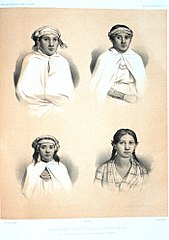
About 10,000 years ago, migrating Native Americans settled in fertile valleys and coastal areas of what is present-day Chile. Settlement sites from very early human habitation include Monte Verde, Cueva del Milodon and the Pali Aike Crater's lava tube. The Incas briefly extended their empire into what is now northern Chile, but the Mapuche (or Araucanians as they were known by the Spaniards) successfully resisted many attempts by the Inca Empire to subjugate them, despite their lack of state organization. They fought against the Sapa Inca Tupac Yupanqui and his army. The result of the bloody three-day confrontation known as the Battle of the Maule was that the Inca conquest of the territories of Chile ended at the Maule river.
Spanish colonization
Main articles: Conquest of Chile and Colonial ChileIn 1520, while attempting to circumnavigate the globe, Ferdinand Magellan discovered the southern passage now named after him, the Strait of Magellan, thus becoming the first European to set foot on what is now Chile. The next Europeans to reach Chile were Diego de Almagro and his band of Spanish conquistadors, who came from Peru in 1535 seeking gold. The Spanish encountered various cultures that supported themselves principally through slash-and-burn agriculture and hunting.
The conquest of Chile began in earnest in 1540 and was carried out by Pedro de Valdivia, one of Francisco Pizarro's lieutenants, who founded the city of Santiago on 12 February 1541. Although the Spanish did not find the extensive gold and silver they sought, they recognized the agricultural potential of Chile's central valley, and Chile became part of the Spanish Empire.

Conquest took place gradually, and the Europeans suffered repeated setbacks. A massive Mapuche insurrection that began in 1553 resulted in Valdivia's death and the destruction of many of the colony's principal settlements. Subsequent major insurrections took place in 1598 and in 1655. Each time the Mapuche and other native groups revolted, the southern border of the colony was driven northward. The abolition of slavery by the Spanish crown in 1683 was done in recognition that enslaving the Mapuche intensified resistance rather than cowing them into submission. Despite royal prohibitions, relations remained strained from continual colonialist interference.
Cut off to the north by desert, to the south by the Mapuche, to the east by the Andes Mountains, and to the west by the ocean, Chile became one of the most centralized, homogeneous colonies in Spanish America. Serving as a sort of frontier garrison, the colony found itself with the mission of forestalling encroachment by both the Mapuche and Spain's European enemies, especially the British and the Dutch. Buccaneers and English adventurers menaced the colony in addition to the Mapuche, as was shown by Sir Francis Drake's 1578 raid on Valparaíso, the colony's principal port. Chile hosted one of the largest standing armies in the Americas, making it one of the most militarized of the Spanish possessions, as well as a drain on the treasury of the Viceroyalty of Peru.
The first general census was conducted by the government of Agustín de Jáuregui between 1777 and 1778; it indicated that the population consisted of 259,646 inhabitants: 73.5 percent of European descent, 7.9 percent mestizos, 8.6 percent indigenous peoples and 9.8 percent blacks. Francisco Hurtado, Governor of the province of Chiloé, conducted a census in 1784 and found the population consisted of 26,703 inhabitants, 64.4 percent of which were whites and 33.5 percent of which were natives.
The Diocese of Concepción conducted a census in areas south of the Maule river in 1812, but did not include the indigenous population or the inhabitants of the province of Chiloé. The population is estimated at 210,567, 86.1 percent of which were Spanish or of European descent, 10 percent of which were indigenous and 3.7 percent of which were mestizos, blacks and mulattos.
Independence and nation building
See also: Argentine–Chilean naval arms race
In 1808, Napoleon's enthronement of his brother Joseph as the Spanish King precipitated the drive by the colony for independence from Spain. A national junta in the name of Ferdinand – heir to the deposed king – was formed on 18 September 1810. The Government Junta of Chile proclaimed Chile an autonomous republic within the Spanish monarchy (in memory of this day Chile celebrates its National Day on 18 September each year).
After these events, a movement for total independence, under the command of José Miguel Carrera (one of the most renowned patriots) and his two brothers Juan José and Luis Carrera, soon gained a wider following. Spanish attempts to re-impose arbitrary rule during what was called the Reconquista led to a prolonged struggle, including infighting from Bernardo O'Higgins, who challenged Carrera's leadership.
Intermittent warfare continued until 1817. With Carrera in prison in Argentina, O'Higgins and anti-Carrera cohort José de San Martín, hero of the Argentine War of Independence, led an army that crossed the Andes into Chile and defeated the royalists. On 12 February 1818 Chile was proclaimed an independent republic. The political revolt brought little social change, however, and 19th-century Chilean society preserved the essence of the stratified colonial social structure, which was greatly influenced by family politics and the Roman Catholic Church. A strong presidency eventually emerged, but wealthy landowners remained powerful.
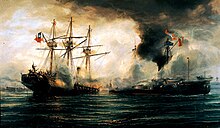
Chile slowly started to expand its influence and to establish its borders. By the Tantauco Treaty, the archipelago of Chiloé was incorporated in 1826. The economy began to boom due to the discovery of silver ore in Chañarcillo, and the growing trade of the port of Valparaíso, which led to conflict over maritime supremacy in the Pacific with Peru. At the same time, attempts were made to strengthen sovereignty in southern Chile intensifying penetration into Araucanía and colonizing Llanquihue with German immigrants in 1848. Through the founding of Fort Bulnes by the Schooner Ancud under the command of John William Wilson, the Magallanes region joined the country in 1843, while the Antofagasta area, at the time part of, Bolivia, began to fill with people.
Toward the end of the 19th century, the government in Santiago consolidated its position in the south by the Occupation of Araucanía. The Boundary treaty of 1881 between Chile and Argentina confirmed Chilean sovereignty over the Strait of Magellan. As a result of the War of the Pacific with Peru and Bolivia (1879–83), Chile expanded its territory northward by almost one-third, eliminating Bolivia's access to the Pacific, and acquired valuable nitrate deposits, the exploitation of which led to an era of national affluence.
The 1891 Chilean Civil War brought about a redistribution of power between the President and Congress, and Chile established a parliamentary style democracy. However, the Civil War had also been a contest between those who favored the development of local industries and powerful Chilean banking interests, particularly the House of Edwards who had strong ties to foreign investors. Soon after, the country engaged in a vastly expensive naval arms race with Argentina that nearly led to a war.
20th century
See also: South American dreadnought raceThe Chilean economy partially degenerated into a system protecting the interests of a ruling oligarchy. By the 1920s, the emerging middle and working classes were powerful enough to elect a reformist president, Arturo Alessandri, whose program was frustrated by a conservative congress. In the 1920s, Marxist groups with strong popular support arose.
A military coup led by General Luis Altamirano in 1924 set off a period of political instability that lasted until 1932. Of the ten governments that held power in that period, the longest lasting was that of General Carlos Ibáñez del Campo, who briefly held power in 1925 and then again between 1927 and 1931 in what was a de facto dictatorship (although not really comparable in harshness or corruption to the type of military dictatorship that has often bedeviled the rest of Latin America).
By relinquishing power to a democratically elected successor, Ibáñez del Campo retained the respect of a large enough segment of the population to remain a viable politician for more than thirty years, in spite of the vague and shifting nature of his ideology. When constitutional rule was restored in 1932, a strong middle-class party, the Radicals, emerged. It became the key force in coalition governments for the next 20 years. During the period of Radical Party dominance (1932–52), the state increased its role in the economy. In 1952, voters returned Ibáñez del Campo to office for another six years. Jorge Alessandri succeeded Ibáñez del Campo in 1958, bringing Chilean conservatism back into power democratically for another term.
The 1964 presidential election of Christian Democrat Eduardo Frei Montalva by an absolute majority initiated a period of major reform. Under the slogan "Revolution in Liberty", the Frei administration embarked on far-reaching social and economic programs, particularly in education, housing, and agrarian reform, including rural unionization of agricultural workers. By 1967, however, Frei encountered increasing opposition from leftists, who charged that his reforms were inadequate, and from conservatives, who found them excessive. At the end of his term, Frei had not fully achieved his party's ambitious goals.

In the 1970 election, Senator Salvador Allende of the Socialist Party of Chile (then part of the "Popular Unity" coalition which included the Communists, Radicals, Social-Democrats, dissident Christian Democrats, the Popular Unitary Action Movement, and the Independent Popular Action), achieved a partial majority in a plurality of votes in a three-way contest, followed by candidates Radomiro Tomic for the Christian Democrat Party and Jorge Alessandri for the Conservative Party. Allende was not elected with an absolute majority, receiving fewer than 35 percent of votes.
The Chilean Congress conducted a runoff vote between the leading candidates, Allende and former president Jorge Alessandri and keeping with tradition, chose Allende by a vote of 153 to 35. Frei refused to form an alliance with Alessandri to oppose Allende, on the grounds that the Christian Democrats were a workers party and could not make common cause with the right-wing.
An economic depression that began in 1972 was exacerbated by capital flight, plummeting private investment, and withdrawal of bank deposits in response to Allende's socialist program. Production fell and unemployment rose. Allende adopted measures including price freezes, wage increases, and tax reforms, to increase consumer spending and redistribute income downward. Joint public-private public works projects helped reduce unemployment. Much of the banking sector was nationalized. Many enterprises within the copper, coal, iron, nitrate, and steel industries were expropriated, nationalized, or subjected to state intervention. Industrial output increased sharply and unemployment fell during the Allende administration's first year.
Allende's program included advancement of workers' interests, replacing the judicial system with "socialist legality", nationalization of banks and forcing others to bankruptcy, and strengthening "popular militias" known as MIR. Started under former President Frei, the Popular Unity platform also called for nationalization of Chile's major copper mines in the form of a constitutional amendment. The measure was passed unanimously by Congress.
As a result, the Richard Nixon administration organized and inserted secret operatives in Chile, in order to swiftly destabilize Allende’s government. In addition, US financial pressure restricted international economic credit to Chile.
The economic problems were also exacerbated by Allende's public spending which was financed mostly by printing money and poor credit ratings given by commercial banks. Simultaneously, opposition media, politicians, business guilds and other organizations helped to accelerate a campaign of domestic political and economical destabilization, some of which was backed by the United States. By early 1973, inflation was out of control. The crippled economy was further battered by prolonged and sometimes simultaneous strikes by physicians, teachers, students, truck owners, copper workers, and the small business class. On 26 May 1973, Chile’s Supreme Court, which was opposed to Allende's government, unanimously denounced the Allende disruption of the legality of the nation. Although illegal under the Chilean constitution, the court supported and strengthened Pinochet's seizure of power.
Pinochet Era (1973–1990)
Main article: Military government of Chile (1973–1990)

A military coup overthrew Allende on 11 September 1973. As the armed forces bombarded the presidential palace, Allende apparently committed suicide. After the coup, Henry Kissinger told U.S. president Richard Nixon that the United States had "helped" the coup.
A military junta, led by General Augusto Pinochet Ugarte, took control of the country. The first years of the regime were marked by human rights violations. On October 1973, at least 72 people were murdered by the Caravan of Death. According to the Rettig Report and Valech Commission, at least 2,115 were killed, and at least 27,265 were tortured (including 88 children younger than 12 years old). At the national stadium, filled with detainees, one of those tortured and killed was internationally known poet-singer Victor Jara (see "Music and Dance", below). The stadium was renamed for Jara in 2003. In September 2013, Pedro Barrientos, Pinochet's commander at the stadium and now a resident of Florida, was sued in a United States federal court by the Center for Justice and Accountability, on behalf of Jara's widow and children.
A new Constitution was approved by a controversial plebiscite on 11 September 1980, and General Pinochet became president of the republic for an 8-year term. After Pinochet obtained rule of the country, several hundred committed Chilean revolutionaries joined the Sandinista army in Nicaragua, guerrilla forces in Argentina or training camps in Cuba, Eastern Europe and Northern Africa.
In the late 1980s, largely as a result of events such as the 1982 economic collapse and mass civil resistance in 1983–88, the government gradually permitted greater freedom of assembly, speech, and association, to include trade union and political activity. The government launched market-oriented reforms with Hernán Büchi as Minister of Finance. Chile moved toward a free market economy that saw an increase in domestic and foreign private investment, although the copper industry and other important mineral resources were not opened for competition. In a plebiscite on 5 October 1988, General Pinochet was denied a second 8-year term as president (56% against 44%). Chileans elected a new president and the majority of members of a two-chamber congress on 14 December 1989. Christian Democrat Patricio Aylwin, the candidate of a coalition of 17 political parties called the Concertación, received an absolute majority of votes (55%). President Aylwin served from 1990 to 1994, in what was considered a transition period.
In December 1993, Christian Democrat Eduardo Frei Ruiz-Tagle, the son of previous president Eduardo Frei Montalva, led the Concertación coalition to victory with an absolute majority of votes (58%).
21st century
See also: 2010 Chile earthquake and 2011–2012 Chilean protests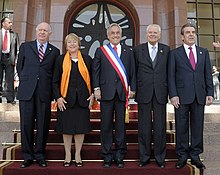
Frei Ruiz-Tagle was succeeded in 2000 by Socialist Ricardo Lagos, who won the presidency in an unprecedented runoff election against Joaquín Lavín of the rightist Alliance for Chile. In January 2006, Chileans elected their first female president, Michelle Bachelet Jeria, of the Socialist Party, defeating Sebastián Piñera, of the National Renewal party, extending the Concertación governance for another four years. In January 2010, Chileans elected Sebastián Piñera as the first rightist President in 20 years, defeating former President Eduardo Frei Ruiz-Tagle of the Concertación, for a four-year term succeeding Bachelet.
On 27 February 2010, Chile was struck by an 8.8 MW earthquake, the fifth largest ever recorded at the time. More than 500 people died (most from the ensuing tsunami) and over a million people lost their homes. The earthquake was also followed by multiple aftershocks. Initial damage estimates were in the range of US$15–30 billion, around 10 to 15 percent of Chile's real gross domestic product.
Chile achieved global recognition for the successful rescue of 33 trapped miners in 2010. On 5 August 2010 the access tunnel collapsed at the San Jose copper and gold mine in the Atacama Desert near Copiapó in northern Chile, trapping 33 men 700 metres (2,300 ft) below ground. A rescue effort organized by the Chilean government located the miners 17 days later. All 33 men were brought to the surface on 13 October 2010 over a period of almost 24 hours, an effort that was carried on live television around the world.
Geography, climate, and environment
Main article: Geography of Chile See also: Environmental issues in Chile

A long and narrow coastal Southern Cone country on the west side of the Andes Mountains, Chile stretches over 4,300 km (2,670 mi) north to south, but only 350 km (217 mi) at its widest point east to west. This encompasses a remarkable variety of climates and landscapes. It contains 756,950 square kilometres (292,260 sq mi) of land area. It is situated within the Pacific Ring of Fire. Including its offshore islands, but excluding its Antarctic claim, Chile lies between latitudes 17° and 56°S, and longitudes 66° and 81°W.
Chile is among the longest north-south countries in the world. If one considers only mainland territory, Chile is unique within this group in its narrowness from east to west, with the other long north-south countries (including Brazil, Russia, Canada, and the USA, among others) all being wider from east to west by a factor of more than 10. Chile also claims 1,250,000 km (480,000 sq mi) of Antarctica as part of its territory. However, this latter claim is suspended under the terms of the Antarctic Treaty, of which Chile is a signatory.
Chile controls Easter Island and Sala y Gómez Island, the easternmost islands of Polynesia, which it incorporated to its territory in 1888, and Robinson Crusoe Island, more than 600 km (370 mi) from the mainland, in the Juan Fernández Islands. Also controlled but only temporarily inhabited (by some local fishermen) are the small islands of San Ambrosio and San Felix. These islands are notable because they extend Chile's claim to territorial waters out from its coast into the Pacific Ocean.
The northern Atacama Desert contains great mineral wealth, primarily copper and nitrates. The relatively small Central Valley, which includes Santiago, dominates the country in terms of population and agricultural resources. This area is also the historical center from which Chile expanded in the late 19th century, when it integrated the northern and southern regions. Southern Chile is rich in forests, grazing lands, and features a string of volcanoes and lakes. The southern coast is a labyrinth of fjords, inlets, canals, twisting peninsulas, and islands. The Andes Mountains are located on the eastern border.
Largest cities
| Largest cities or towns in Chile 2002 Census | |||||||||
|---|---|---|---|---|---|---|---|---|---|
| Rank | Name | Region | Pop. | ||||||
 Santiago Metropolis  Greater Valparaíso |
1 | Santiago Metropolis | Santiago Metropolitan Region | 5,428,590 |  Greater Concepción  Greater La Serena | ||||
| 2 | Greater Valparaíso | Valparaíso Region | 803,683 | ||||||
| 3 | Greater Concepción | Biobío Region | 666,381 | ||||||
| 4 | Greater La Serena | Coquimbo Region | 296,253 | ||||||
| 5 | Antofagasta | Antofagasta Region | 285,255 | ||||||
| 6 | Greater Temuco | Araucanía Region | 260,878 | ||||||
| 7 | Rancagua conurbation | O'Higgins Region | 236,363 | ||||||
| 8 | Talca | Maule Region | 191,154 | ||||||
| 9 | Arica | Arica and Parinacota Region | 175,441 | ||||||
| 10 | Chillán conurbation | Ñuble Region | 165,528 | ||||||
.
Climate
Main article: Climate of Chile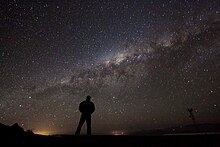
The diverse climate of Chile ranges from the world's driest desert in the north—the Atacama Desert—through a Mediterranean climate in the centre, humid subtropical in Easter Island, to an oceanic climate, including alpine tundra and glaciers in the east and south. According to the Köppen system, Chile within its borders hosts at least seven major climatic subtypes. There are four seasons in most of the country: summer (December to February), autumn (March to May), winter (June to August), and spring (September to November).
Biodiversity
Main article: Wildlife of Chile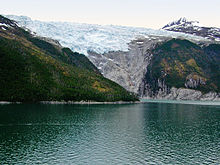

Chile's geographical isolation also has restricted the immigration of faunal life, so that only a few of the many distinctive South American animals are found. Among the larger mammals are the puma or cougar, the llama-like guanaco and the fox-like chilla. In the forest region, several types of marsupials and a small deer known as the pudu are found.
There are many species of small birds, but most of the larger common Latin American types are absent. Few freshwater fish are native, but North American trout have been successfully introduced into the Andean lakes. Owing to the vicinity of the Humboldt Current, ocean waters abound with fish and other forms of marine life, which in turn support a rich variety of waterfowl, including several penguins. Whales are abundant, and some six species of seals are found in the area.
Just over 3,000 species of fungi are recorded in Chile, but this number is far from complete. The true total number of fungal species occurring in Chile is likely to be far higher, given the generally accepted estimate that only about 7 percent of all fungi worldwide have so far been discovered. Although the amount of available information is still very small, a first effort has been made to estimate the number of fungal species endemic to Chile, and 1995 species have been tentatively identified as possible endemics of the country.
The northernmost coastal and central region is largely barren of vegetation, approaching the most closely an absolute desert in the world. On the slopes of the Andes, besides the scattered tola desert brush, grasses are found. The central valley is characterized by several species of cacti, the hardy espinos, the Chilean pine, the southern beeches and the copihue, a red bell-shaped flower that is Chile's national flower.
In southern Chile, south of the Biobío River, heavy precipitation has produced dense forests of laurels, magnolias, and various species of conifers and beeches, which become smaller and more stunted to the south. The cold temperatures and winds of the extreme south preclude heavy forestation. Grassland is found in Atlantic Chile (in Patagonia). Much of the Chilean flora is distinct from that of neighboring Argentina, indicating that the Andean barrier existed during its formation.
Flora

The native flora of Chile is characterized by a higher degree of endemism and relatively fewer species compared to the flora of other countries of South America. A classification of this flora necessitates its division into at least three general zones: the desert provinces of the north, Central Chile, and the humid regions of the south.
Fauna

The fauna of Chile is characterized by a high degree of endemism, due to its particular geography. In continental Chile, the Atacama Desert in the north and the Andes mountains to the east are barriers that have led to the isolation of flora and fauna. Add to that the enormous extension in length (over 4,200 km (2,610 mi)) this results in a wide range of climates and environments.
-
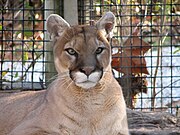 Puma in Chile (Cougar).
Puma in Chile (Cougar).
-
 Araucaria araucana trees in Conguillío National Park
Araucaria araucana trees in Conguillío National Park
-
Pudú in Chile
-
Chilla Fox, common in the region
-
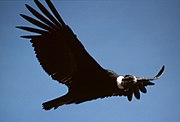 Andean Condor (Vultur gryphus), the national bird of Chile
Andean Condor (Vultur gryphus), the national bird of Chile
-
 Lycalopex culpaeus, A Culpeo or Andean Fox
Lycalopex culpaeus, A Culpeo or Andean Fox
-
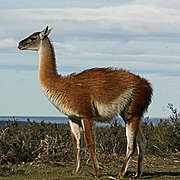 A Guanaco in northern Chile
A Guanaco in northern Chile
-
 Torres del Paine from Lake Pehoé, Torres del Paine National Park, Chile.
Torres del Paine from Lake Pehoé, Torres del Paine National Park, Chile.
Topography
Chile is located along a highly seismic and volcanic zone, part of the Pacific Ring of Fire, due to the subduction of the Nazca and Antarctic plates in the South American plate.





Late Paleozoic, 251 million years ago, Chile belonged to the continental block called Gondwana. It was just a depression accumulated marine sediments began to rise at the end of the Mesozoic, 66 million years ago, due to the collision between the Nazca and South American plates, resulting in the Andes. The territory would be shaped by millions of years due to the folding of the rocks, forming the current relief.
The Chilean relief consists of the central depression, which crosses the country longitudinally, flanked by two mountain ranges that make up about 80% of the territory: the Andes mountains to the east-natural border with Bolivia and Argentina, with its most alton 18 located on the Nevado Ojos del Salado, at 6891.3 m, the highest volcano in the world, in the region of Atacama and Coastal Range west-minor height from the Andes, with its highest point located on the hill Vicuña Mackenna, at 3114 meters, located in the Sierra Vicuña Mackenna, the south of Antofagasta. Among the coastal mountains and the Pacific is a series of coastal plains, of variable length, which allow the settlement of coastal towns and big ports. Some areas of the plains territories encompass territory east of the Andes, and the Patagonian steppes and Magellan, or are high plateaus surrounded by high mountain ranges, such as the Altiplano or Puna de Atacama.
The Far North is the area between the northern boundary of the country and the parallel 26° S, covering the first three regions. It is characterized by the presence of the Atacama desert, the most arid in the world. The desert is fragmented by streams that originate in the area known as the pampas Tamarugal. The Andes, split in two and whose eastern arm runs Bolivia, has a high altitude and volcanic activity, which has allowed the formation of the Andean altiplano and salt structures as the Salar de Atacama, due to the gradual accumulation of sediments over time.
To the south is the Norte Chico, extending to the Aconcagua river. Los Andes begin to decrease its altitude to the south and closer to the coast, reaching 90 km away at the height of Illapel, the narrowest part of the Chilean territory. The two mountain ranges intersect, virtually eliminating the intermediate depression. The existence of rivers flowing through the territory allows the formation of transverse valleys, where agriculture has developed strongly in recent times, while the coastal plains begin to expand.
| Ten highest peaks of Chile | |
| Name | Altitude(m) |
|---|---|
| Nevado Ojos del Salado | 6891,3 |
| Nevado Tres Cruces | 6758 |
| Llullaillaco | 6739 |
| Incahuasi | 6638 |
| Tupungato | 6565 |
| Ata Volcano | 6501 |
| Cerro El Muerto | 6488 |
| Parinacota | 6342 |
| Pomerape | 6282 |
| Los Patos | 6239 |
| Note: shared with Argentina, shared with Bolivia. | |
The Central area is the most populated region of the country. The coastal plains are wide and allow the establishment of cities and ports along the Pacific, while the coastal mountains down its height. The Andes maintains altitudes above 6000m but descend slowly starts approaching the 4000 meters on average. The intermediate depression reappears becoming a fertile valley that allows agricultural development and human settlement, due to sediment accumulation. To the south, the Cordillera de la Costa reappears in the range of Nahuelbuta while glacial sediments originate a series of lakes in the area of La Frontera.
Patagonia extends from within Reloncavi, at the height of parallel 41 ° S, to the south. During the last glaciation, this area was covered by ice that strongly eroded Chilean relief structures. As a result, the intermediate depression sinks in the sea, while the coastal mountains rise to a series of archipelagos, such as Chiloé and the Chonos, disappearing in Taitao peninsula, in the parallel 47 ° S. The Andes mountain range loses height and erosion caused by the action of glaciers has caused fjords.
East of the Andes, on the continent, or north of it, on the island of Tierra del Fuego are located relatively flat plains, which in the Strait of Magellan cover large areas.
The Andes, as he had done previously Cordillera de la Costa, begins to break in the ocean causing a myriad of islands and islets and disappear into it, sinking and reappearing in the Southern Antilles arc and then the Antarctic Peninsula, where it is called Antartandes, in the Chilean Antarctic Territory, lying between the meridians 53 ° W and 90 ° W.
In the middle of the Pacific, the country has sovereignty over several islands of volcanic origin, collectively known as Insular Chile. Of these, we highlight the archipelago of Juan Fernandez and Easter Island, which is located in the fracture zone between the Nazca plate and the Pacific plate known as East Pacific Rise.
Hydrography

| Ten longest rivers of Chile | |
| Name | Length (km) |
|---|---|
| Loa | 440 |
| Bío Bío | 380 |
| Baker | 370 |
| Copiapó | 292 |
| Maipo | 250 |
| Yelcho-Futaleufú | 246 |
| Maule | 240 |
| Palena | 240 |
| Toltén | 231 |
| Huasco | 230 |
| Note: All lengths exclusively through Chilean territory. | |
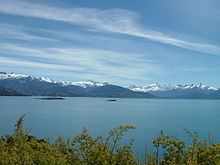

Due to the characteristics of the territory, Chile is crossed by numerous rivers generally short in length and with low torrential flow. They commonly extend from the Andes to the Pacific Ocean, flowing in an East to West direction.
Because of the desert, in the Norte Grande there are only short endorheic character streams, except for the river Loa, the longest in the country 440 km. In the high valleys, wetland areas generate Chungará Lake, located at 4500 meters above sea level. It and the river Lauca are shared with Bolivia, as well as the Lluta.
In the center-north of the country, the number of rivers that form valleys of agricultural importance increases. Noteworthy are the Elqui with 75 km long, 142 km Aconcagua, Maipo with 250 km and its tributary, the Mapocho with 110 km, and Maule with 240 km. Their waters mainly flow from Andean snowmelt in the summer and winter rains. The major lakes in this area are the artificial lake Rapel, the Colbun Maule lagoon and the lagoon of La Laja.
Demographics
Main article: Demographics of Chile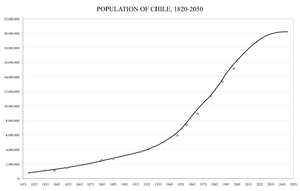
Chile's 2002 census reported a population of 15 million people. Its rate of population growth has been decreasing since 1990, due to a declining birth rate. By 2050 the population is expected to reach approximately 20.2 million people. About 85 percent of the country's population lives in urban areas, with 40 percent living in Greater Santiago. The largest agglomerations according to the 2002 census are Greater Santiago with 5.6 million people, Greater Concepción with 861,000 and Greater Valparaíso with 824,000.
Ethnic groups
Main articles: Indigenous peoples in Chile and Immigration to ChileChile is a multiethnic society, home to people of many different ethnic backgrounds. Studies on the ethnic structure of Chile vary significantly from one another.
For example, the Mexican professor Francisco Lizcano, of the National Autonomous University of Mexico, estimated that 52.7% of Chileans would be Caucasians, 39.3% would be mestizo, and 8% would be amerindian.
The most recent study in the Candela Project establishes that the genetic composition of Chile is originated in a 44% from the Natives Americans (Amerindians), with 52% of the genome coming from Europe, and a 4% coming from Africa; making Chile a primarily mestizo country, with African traces present in half of the population. Also, another genetic study conducted by the University of Brasilia in several American countries, shows a similar genetic composition for Chile, with a European contribution of 51.6%, an Amerindian (Native) contribution of 42.1%, and an African contribution of 6.3%.
A public health booklet from the University of Chile states that 30% of the population is of Caucasian origin; "predominantly White" Mestizos are estimated to amount a total of 65%, while Native Americans (Amerindians) comprise the remaining 5%.
Despite the genetic considerations, many Chileans, if asked, would self-identify as White. The 2011 Latinobarómetro survey asked respondents in Chile what race they considered themselves to belong to. Most answered "White" (59%), while 25% said "Mestizo" and 8% self-classified as "indigenous". A 2002 national poll revealed that a majority of Chileans believed they possessed some (43.4%) or much (8.3%) "indigenous blood", while 40.3% responded that they had none.
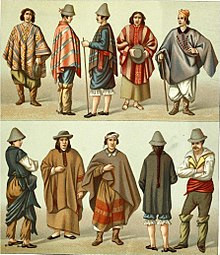
The 1907 census reported 101,118 Indians, or 3.1 percent of the total population. Only those that practiced their native culture or spoke their native language were considered, irrespective of their "racial purity".
In 2002 a census took place, directly asking the public whether they considered themselves as part of any of the eight Chilean ethnic groups, regardless of whether or not they maintained their culture, traditions and language, and 4.6 percent of the population (692,192 people) fitted that description of indigenous peoples in Chile. Of that, 87.3 percent declared themselves Mapuche. Most of the indigenous population show varying degrees of mixed ancestry.
Chile is one of 22 countries to have signed and ratified the only binding international law concerning indigenous peoples, Indigenous and Tribal Peoples Convention, 1989. It was adopted in 1989 as the International Labour Organization (ILO) Convention 169. Chile ratified it in 2008. A Chilean court decision in November 2009, considered to be a landmark ruling on indigenous rights, made use of the convention. The Supreme Court decision on Aymara water rights upheld rulings by both the Pozo Almonte tribunal and the Iquique Court of Appeals, and marks the first judicial application of ILO Convention 169 in Chile.
Chile was never a particularly attractive destination for migrants, owing to its remoteness and distance from Europe. Europeans preferred to stay in countries closer to their homelands instead of taking the long journey through the Straits of Magellan or crossing the Andes, thus mostly having Argentina, Brazil or Uruguay as a preferred settling country. European migration did not result in a remarkable change in the ethnic composition of Chile, except in the region of Magellan. Spaniards were the only major European migrant group to Chile, and there was never large scale immigration, as what occurred in Argentina or Uruguay. Between 1851 and 1924 Chile only received 0.5% of European immigration to Latin America, compared to 46% to Argentina, 33% to Brazil, 14% to Cuba, and 4% to Uruguay. However, it is undeniable that immigrants have played a significant role in Chilean society.
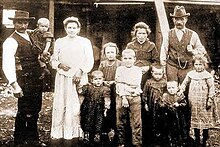
Other groups of Europeans have followed but are found in smaller numbers, as the descendants of Austrians and Dutchmen it is currently estimated at about 50,000 people. After the failed liberal revolution of 1848 in the German states, a noticeable German immigration took place, laying the foundation for the German-Chilean community. Sponsored by the Chilean government to "unbarbarize" and colonize the southern region, these Germans (including German-speaking Swiss, Silesians, Alsatians and Austrians) settled mainly in Valdivia, Chiloé and Los Ángeles.
Descendants of different European ethnic groups often intermarried in Chile. This intermarriage and mixture of cultures and races has help shape the present society and culture of the Chilean middle and upper classes.
Due in part to its economic fortunes, Chile has recently become a new magnet for immigrants, mostly from neighboring Argentina, Bolivia and mainly Peru. According to the 2002 national census, Chile's foreign-born population has increased by 75% since 1992. According to an estimate by the Migration and Foreign Residency Department, 317,057 foreigners were living in Chile as of December 2008. Roughly 500,000 of Chile’s population is of full or partial Palestinian origin.
Religion
Main article: Religion in Chile| Religious background in Chile | ||||
|---|---|---|---|---|
| Religion | Percent | |||
| Roman Catholic | 66.6% | |||
| None | 12.4% | |||
| Protestant | 17% | |||
| Other | 4% | |||
As of 2012, 66.6% of Chilean population over 15 years of age claims to be of Catholic creed – a decrease from the 70% reported by the 2002 census. In the most recent census (2002), 70 percent of the population over age 14 identified as Roman Catholic and 15.1 percent as evangelical. In the census, the term "evangelical" referred to all non-Catholic Christian churches with the exception of the Orthodox Church (Greek, Persian, Serbian, Ukrainian, and Armenian), The Church of Jesus Christ of Latter-day Saints (Mormons), Seventh-day Adventists, and Jehovah's Witnesses. Approximately 90 percent of evangelicals are Pentecostal. Wesleyan, Lutheran, Reformed Evangelical, Presbyterian, Anglican, Episcopalian, Baptist and Methodist churches are also present. Irreligious people, atheists, and agnostics account for around 8 percent of the population.
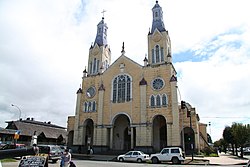
The Constitution provides for freedom of religion, and other laws and policies contribute to the generally free practice of religion. The law at all levels protects this right in full against abuse, either by governmental or private actors.
Church and state are officially separate in Chile. The 1999 law on religion prohibits religious discrimination. However, the Catholic Church enjoys a privileged status and occasionally receives preferential treatment. Government officials attend Catholic events as well as major Protestant and Jewish ceremonies.
The Government-observed religious holidays include Christmas, Good Friday, the Feast of the Virgin of Carmen, the Feast of Saints Peter and Paul, the Feast of the Assumption, All Saints' Day, and the Feast of the Immaculate Conception as national holidays. The government has recently declared 31 October, Reformation Day, a public national holiday, in honor of the Protestant churches of the country.
The patron saints of Chile are Our Lady of Mount Carmel and Saint James the Greater (Santiago). In 2005, St. Alberto Hurtado was canonized by Pope Benedict XVI and became the country's second saint after St. Teresa de los Andes.
Languages
The Spanish spoken in Chile is distinctively accented and quite unlike that of neighbouring South American countries because final syllables and "s" sounds are often dropped, and some consonants have a soft pronunciation. Accent varies only very slightly from north to south; more noticeable are the differences in accent based on social class or whether one lives in the city or the country. That the Chilean population was largely formed in a small section at the center of the country and then migrated in modest numbers to the north and south helps explain this relative lack of differentiation, which was maintained by the national reach of radio, and now television, which also helps to diffuse and homogenize colloquial expressions.
There are several indigenous languages spoken in Chile: Mapudungun, Quechua, Aymara and Rapa Nui. After the Spanish invasion, Spanish took over as the lingua franca and the indigenous languages have become minority languages, with some now extinct or close to extinction.
German is still spoken to some extent in southern Chile, either in small country side pockets or as a second language among the communities of larger cities.
Through initiatives such as the English Opens Doors Program, the government made English mandatory for students in fifth-grade and above in public schools. Most private schools in Chile start teaching English from kindergarten. Common English words have been absorbed and appropriated into everyday Spanish speech.
Identity and traditions

Due to the geography of Chile dissimilar cultural expressions vary markedly in different parts of the country.
Government and politics
Main articles: Politics of Chile and Law of Chile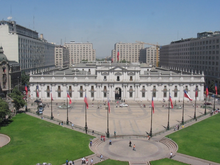

The current Constitution of Chile was approved in a national plebiscite —regarded as "highly irregular" by some observers— in September 1980, under the military government of Augusto Pinochet. It entered into force in March 1981. After Pinochet's defeat in the 1988 plebiscite, the constitution was amended to ease provisions for future amendments to the Constitution. In September 2005, President Ricardo Lagos signed into law several constitutional amendments passed by Congress. These include eliminating the positions of appointed senators and senators for life, granting the President authority to remove the commanders-in-chief of the armed forces, and reducing the presidential term from six to four years.
The Congress of Chile has a 38-seat Senate and a 120-member Chamber of Deputies. Senators serve for eight years with staggered terms, while deputies are elected every 4 years. The current Senate has a 20–18 split in favor of the opposition coalition. The last congressional elections were held on 13 December 2009, concurrently with the presidential election. The current lower house-the Chamber of Deputies-contains 58 members of the governing center-right coalition, 54 from the center-left opposition and 8 from small parties or independents. The Congress is located in the port city of Valparaíso, about 140 kilometres (87 miles) west of the capital, Santiago.
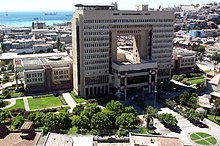
Chile's congressional elections are governed by a binomial system that, for the most part, rewards the two largest representations equally, often regardless of their relative popular support. Parties are thus forced to form wide coalitions and, historically, the two largest coalitions (Concertación and Alianza) split most of the seats. Only if the leading coalition ticket out-polls the second place coalition by a margin of more than 2-to-1 does the winning coalition gain both seats, which tends to lock the legislative in a roughly 50-50 split.
Chile's judiciary is independent and includes a court of appeal, a system of military courts, a constitutional tribunal, and the Supreme Court of Chile. In June 2005, Chile completed a nationwide overhaul of its criminal justice system. The reform has replaced inquisitorial proceedings with an adversarial system more similar to that of the United States.
In the 2001 congressional elections, the conservative Independent Democratic Union (UDI) surpassed the Christian Democrats for the first time to become the largest party in the lower house. In the 2005 parliamentary election, both leading parties, the Christian Democrats and the UDI lost representation in favor of their respective allies Socialist Party (which became the biggest party in the Concertación block) and National Renewal in the right-wing alliance. In the last legislative elections in Chile, the Communist Party won 3 out of 120 seats in the Chamber of Deputies for the first time in 30 years (the Communist Party was not allowed to exist as such during the dictatorship).
Chileans voted in the first round of presidential elections on 13 December 2009. None of the four presidential candidates got more than 50 percent of the vote. As a result, the top two candidates, center-left Concertación de Partidos por la Democracia coalition's Eduardo Frei Ruiz-Tagle and center-right Coalición por el Cambio coalition's Sebastián Piñera, competed in a run-off election on 17 January 2010, which Piñera won. This was Chile's fifth presidential election since the end of the Pinochet era. All five have been judged free and fair. The president is constitutionally barred from serving consecutive terms.
Foreign relations
Main article: Foreign relations of Chile
Since the early decades after independence, Chile has always had an active involvement in foreign affairs. In 1837 the country aggressively challenged the dominance of Peru's port of Callao for preeminence in the Pacific trade routes, defeating the short-lived alliance between Peru and Bolivia, the Peru-Bolivian Confederation (1836–39) in the War of the Confederation. The war dissolved the confederation while distributing power in the Pacific. A second international war, the War of the Pacific (1879–83), further increased Chile's regional role, while adding considerably to its territory.
During the 19th century, Chile's commercial ties were primarily with Britain, a nation that had a major influence on the formation of the Chilean navy. The French influenced Chile's legal and educational systems and had a decisive impact on Chile, through the architecture of the capital in the boom years at the turn of the 20th century. German influence came from the organization and training of the army by Prussians.
On 26 June 1945, Chile participated as a founding member of the United Nations being among 50 countries that signed the United Nations Charter in San Francisco, California. With the military coup of 1973, Chile became isolated politically as a result of widespread human rights abuses.
Since its return to democracy in 1990, Chile has been an active participant in the international political arena. Chile completed a 2-year non-permanent position on the UN Security Council in January 2005. Jose Miguel Insulza, a Chilean national, was elected Secretary General of the Organization of American States in May 2005 and confirmed in his position, being re-elected in 2009. Chile is currently serving on the International Atomic Energy Agency (IAEA) Board of Governors, and the 2007–2008 chair of the board is Chile's ambassador to the IAEA, Milenko E. Skoknic. The country is an active member of the UN family of agencies and participates in UN peacekeeping activities. It was re-elected as a member of the UN Human Rights Council in 2011 for a three-year term. It was also elected to one of five non-permanent seats on the UN Security Council in 2013. Chile hosted the Defense Ministerial of the Americas in 2002 and the APEC summit and related meetings in 2004. It also hosted the Community of Democracies ministerial in April 2005 and the Ibero-American Summit in November 2007. An associate member of Mercosur and a full member of APEC, Chile has been a major player in international economic issues and hemispheric free trade.
The Chilean Government has diplomatic relations with most countries. It settled all its territorial disputes with Argentina during the 1990s except for part of the border at Southern Patagonian Ice Field. Chile and Bolivia severed diplomatic ties in 1978 over Bolivia's desire to regain sovereign access to the Pacific Ocean it lost to Chile in 1879–83 War of the Pacific. The two countries maintain consular relations and are represented at the Consul General level.
Administrative divisions
Main article: Administrative divisions of Chile
Chile is divided into 15 regions, each headed by an intendant appointed by the president. The regions are further divided into provinces, with provincial governors also appointed by the president. Finally each province is divided into communes which are administered by municipalities, each with its own mayor and council elected for four-year terms. Each region is designated by a name and a Roman numeral, assigned from north to south. The only exception is the Santiago Metropolitan Region which is designated RM (Región Metropolitana). Two new regions were created in 2006 and became operative in October 2007; Los Ríos in the south (Region XIV), and Arica y Parinacota in the north (Region XV). The numbering scheme skipped Region XIII, usually assumed to be the Metropolitan Region before the 2006 reform.
| Key | Name | Spanish | Capital |
|---|---|---|---|
| XV | Región de Arica y Parinacota | Arica | |
| I | Región de Tarapacá | Iquique | |
| II | Región de Antofagasta | Antofagasta | |
| III | Región de Atacama | Copiapó | |
| IV | Región de Coquimbo | La Serena | |
| V | Región de Valparaíso | Valparaíso | |
| RM | Región Metropolitana de Santiago | Santiago | |
| VI | Región del Libertador General Bernardo O'Higgins | Rancagua | |
| VII | Región del Maule | Talca | |
| VIII | Región del Biobío | Concepción | |
| IX | Región de la Araucanía | Temuco | |
| XIV | Región de Los Ríos | Valdivia | |
| X | Región de Los Lagos | Puerto Montt | |
| XI | Región Aysén del General Carlos Ibáñez del Campo | Coyhaique | |
| XII | Región de Magallanes y de la Antártica Chilena | Punta Arenas |
National symbols
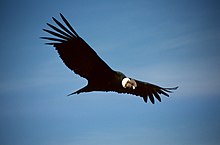
The national flower is the copihue (Lapageria rosea, Chilean bellflower), which grows in the woods of southern Chile.
The coat of arms depicts the two national animals: the condor (Vultur gryphus, a very large bird that lives in the mountains) and the huemul (Hippocamelus bisulcus, an endangered white tail deer). It also has the legend Por la razón o la fuerza (By reason or by force).
The flag of Chile consists of two equal horizontal bands of white (top) and red; there is a blue square the same height as the white band at the hoist-side end of the white band; the square bears a white five-pointed star in the center representing a guide to progress and honor; blue symbolizes the sky, white is for the snow-covered Andes, and red stands for the blood spilled to achieve independence. The flag of Chile is similar to the Flag of Texas, although the Chilean flag is 21 years older. However, like the Texan flag, the flag of Chile is modeled after the Flag of the United States.
Military
Main article: Military of Chile Chilean Army Leopard 2A4CHL |
 Chilean Navy Karel Doorman-class frigate |
 Chilean Air Force F-16 Fighting Falcon |
The Armed Forces of Chile are subject to civilian control exercised by the president through the Minister of Defense. The president has the authority to remove the commanders-in-chief of the armed forces.
The commander in chief of the Chilean Army is General Humberto Oviedo Arriagada. The Chilean Army is 45,000 strong and is organized with an Army headquarters in Santiago, six divisions throughout its territory, an Air Brigade in Rancagua, and a Special Forces Command in Colina. The Chilean Army is one of the most professional and technologically advanced armies in Latin America.
Admiral Enrique Larrañaga Martin directs the 21,773-person Chilean Navy, including 2,500 Marines. Of the fleet of 29 surface vessels, only eight are operational major combatants (frigates). Those ships are based in Valparaíso. The Navy operates its own aircraft for transport and patrol; there are no Navy fighter or bomber aircraft. The Navy also operates four submarines based in Talcahuano.
Air Force General (four star) Jorge Rojas Ávila heads the 12,500 strong Chilean Air Force. Air assets are distributed among five air brigades headquartered in Iquique, Antofagasta, Santiago, Puerto Montt, and Punta Arenas. The Air Force also operates an airbase on King George Island, Antarctica. The Air Force took delivery of the final two of ten F-16s, all purchased from the U.S., in March 2007 after several decades of U.S. debate and previous refusal to sell. Chile also took delivery in 2007 of a number of reconditioned Block 15 F-16s from the Netherlands, bringing to 18 the total of F-16s purchased from the Dutch.
After the military coup in September 1973 the Chilean national police (Carabineros) were incorporated into the Defense Ministry. With the return of democratic government, the police were placed under the operational control of the Interior Ministry but remained under the nominal control of the Defense Ministry. Gen. Gustavo González Jure is the head of the national police force of 40,964 men and women who are responsible for law enforcement, traffic management, narcotics suppression, border control, and counter-terrorism throughout Chile.
Economy
Main article: Economy of Chile
The Central Bank of Chile in Santiago serves as the central bank for the country. The Chilean currency is the Chilean peso (CLP). Chile is one of South America's most stable and prosperous nations, leading Latin American nations in human development, competitiveness, income per capita, globalization, economic freedom, and low perception of corruption. Since July 2013, Chile is considered by the World Bank as a "high-income economy", and hence as a developed country.
Chile has the highest degree of economic freedom in South America (ranking 7th worldwide), owing to its independent and efficient judicial system and prudent public finance management. In May 2010 Chile became the first South American country to join the OECD. In 2006, Chile became the country with the highest nominal GDP per capita in Latin America.
Copper mining makes up 20% of Chilean GDP and 60% of exports. Escondida is the largest copper mine in the world, producing over 5% of global supplies. Overall, Chile produces a third of the world’s copper. Codelco, the state mining firm, competes with private ones.
Sound economic policies, maintained consistently since the 1980s, have contributed to steady economic growth in Chile and have more than halved poverty rates. Chile began to experience a moderate economic downturn in 1999. The economy remained sluggish until 2003, when it began to show clear signs of recovery, achieving 4.0 percent real GDP growth. The Chilean economy finished 2004 with growth of 6 percent. Real GDP growth reached 5.7 percent in 2005 before falling back to 4 percent in 2006. GDP expanded by 5 percent in 2007. Faced with an international economic downturn the government announced a $4 billion economic stimulus plan to spur employment and growth, and despite the global financial crisis, aimed for an expansion of between 2 percent and 3 percent of GDP for 2009. Nonetheless, economic analysts disagreed with government estimates and predicted economic growth at a median of 1.5 percent. Real GDP growth in 2012 was 5.5%. Growth slowed to 4.1% in the first quarter of 2013.
The unemployment rate was 6.4% in April 2013. There are reported labour shortages in agriculture, mining, and construction. The percentage of Chileans with per capita household incomes below the poverty line—defined as twice the cost of satisfying a person's minimal nutritional needs—fell from 45.1 percent in 1987 to 11.5 percent in 2009, according to government surveys. Critics in Chile, however, argue that true poverty figures are considerably higher than those officially published. Using the relative yardstick favoured in many European countries, 27% of Chileans would be poor, according to Juan Carlos Feres of the ECLAC.

As of November 2012, about 11.1 million people (64% of the population) benefit from government welfare programs, via the "Social Protection Card", which includes the population living in poverty and those at a risk of falling into poverty.
The privatized national pension system (AFP) has encouraged domestic investment and contributed to an estimated total domestic savings rate of approximately 21 percent of GDP. Under the compulsory private pension system, most formal sector employees pay 10 percent of their salaries into privately managed funds. However, by 2009, it has been reported that $21 billion had been lost from the pension system to the global financial crisis.

Chile has signed free trade agreements (FTAs) with a whole network of countries, including an FTA with the United States that was signed in 2003 and implemented in January 2004. Internal Government of Chile figures show that even when factoring out inflation and the recent high price of copper, bilateral trade between the U.S. and Chile has grown over 60 percent since then. Chile's total trade with China reached US$8.8 billion in 2006, representing nearly 66 percent of the value of its trade relationship with Asia. Exports to Asia increased from US $15.2 billion in 2005 to US $19.7 billion in 2006, a 29.9 percent increase. Year-on-year growth in imports was especially strong from a number of countries-Ecuador (123.9%), Thailand (72.1%), Korea (52.6%), and China (36.9%).
Chile's approach to foreign direct investment is codified in the country's Foreign Investment Law. Registration is reported to be simple and transparent, and foreign investors are guaranteed access to the official foreign exchange market to repatriate their profits and capital. The Chilean Government has formed a Council on Innovation and Competition, hoping to bring in additional FDI to new parts of the economy.
Standard & Poor's gives Chile a credit rating of AA-. The Government of Chile continues to pay down its foreign debt, with public debt only 3.9 percent of GDP at the end of 2006. The Chilean central government is a net creditor with a net asset position of 7% of GDP at end 2012. The current account deficit was 4% in the first quarter of 2013, financed mostly by foreign direct investment. 14% of central government revenue came directly from copper in 2012.
Infrastructure
Transport
Main article: Transport in Chile
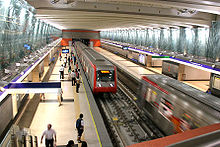
Due to Chile's topography a functioning transport network is vital to its economy. Buses are now the main means of long distance transportation in Chile, following the decline of its railway network. The bus system covers the entire country, from Arica to Santiago (a 30 hour journey) and from Santiago to Punta Arenas (about 40 hours, with a change at Osorno).
Chile has a total of 372 runways (62 paved and 310 unpaved). Important airports in Chile include Chacalluta International Airport (Arica), Diego Aracena International Airport (Iquique), Cerro Moreno International Airport (Antofagasta), Carriel Sur International Airport (Concepción), El Tepual International Airport (Puerto Montt), Presidente Carlos Ibáñez del Campo International Airport (Punta Arenas), Mataveri International Airport (Easter Island), the most remote airport in the world, and the Comodoro Arturo Merino Benítez International Airport (Santiago) with a traffic of 12,105,524 passengers in 2011. Santiago is headquarters of Latin America's largest airline holding company and Chilean flag carrier LAN Airlines.
Telecommunications

Chile has a telecommunication system which covers much of the country, including Chilean insular and Antarctic bases. Privatization of the telephone system began in 1988; Chile has one of the most advanced telecommunications infrastructure in South America with a modern system based on extensive microwave radio relay facilities and domestic satellite system with 3 earth stations. In 2012, there were 3.276 million main lines in use and 24.13 million mobile cellular telephone subscribers. According to a 2012 database of the International Telecommunications Union (ITU), 61.42% of the Chilean population uses the internet, making Chile the country with the highest internet penetration in South America. The Chilean internet country code is ".cl".
Agriculture
Main article: Agriculture in Chile
Agriculture in Chile encompasses a wide range of different activities due to its particular geography, climate and geology and human factors. Historically agriculture is one of the bases of Chile's economy, now agriculture and allied sectors like forestry, logging and fishing accounts only for 4.9% of the GDP as of 2007 and employed 13.6% of the country's labor force. Some major agriculture products of Chile includes grapes, apples, pears, onions, wheat, corn, oats, peaches, garlic, asparagus, beans, beef, poultry, wool, fish and timber. Due to its geographical isolation and strict customs policies Chile is free from diseases such as Mad Cow, fruit fly and Phylloxera, this plus being located in the southern hemisphere (having quite different harvesting times compared to the Northern Hemisphere) and its wide range of agriculture conditions are considered Chiles main comparative advantages. However, the mountainous landscape of Chile limits the extent and intensity of agriculture so that arable land corresponds only to 2.62% of the total territory.
Tourism
Main article: Tourism in Chile

Tourism in Chile has experienced sustained growth over the last few decades. In 2005, tourism grew by 13.6 percent, generating more than 4.5 billion dollars of which 1.5 billion was attributed to foreign tourists. According to the National Service of Tourism (Sernatur), 2 million people a year visit the country. Most of these visitors come from other countries in the American continent, mainly Argentina; followed by a growing number from the United States, Europe, and Brazil with a growing number of Asians from South Korea and PR China.
The main attractions for tourists are places of natural beauty situated in the extreme zones of the country: San Pedro de Atacama, in the north, is very popular with foreign tourists who arrive to admire the Incaic architecture, the altiplano lakes, and the Valley of the Moon. In Putre, also in the north, there is the Chungará Lake, as well as the Parinacota and the Pomerape volcanoes, with altitudes of 6,348 m and 6,282 m, respectively. Throughout the central Andes there are many ski resorts of international repute, including Portillo, Valle Nevado and Termas de Chillán.
The main tourist sites in the south are national parks (the most popular is Conguillío National Park in the Araucanía) and the coastal area around Tirúa and Cañete with the Isla Mocha and the Nahuelbuta National Park, Chiloé Archipelago and Patagonia, which includes Laguna San Rafael National Park, with its many glaciers, and the Torres del Paine National Park. The central port city of Valparaíso, which is World Heritage with its unique architecture, is also popular. Finally, Easter Island in the Pacific Ocean is one of the main Chilean tourist destinations.
For locals, tourism is concentrated mostly in the summer (December to March), and mainly in the coastal beach towns. Arica, Iquique, Antofagasta, La Serena and Coquimbo are the main summer centres in the north, and Pucón on the shores of Lake Villarrica is the main centre in the south. Because of its proximity to Santiago, the coast of the Valparaíso Region, with its many beach resorts, receives the largest number of tourists. Viña del Mar, Valparaíso's northern affluent neighbor, is popular because of its beaches, casino, and its annual song festival, the most important musical event in Latin America. Pichilemu in the O'Higgins Region is widely known as South America's "best surfing spot" according to Fodor's.
In November 2005 the government launched a campaign under the brand "Chile: All Ways Surprising" intended to promote the country internationally for both business and tourism. Museums in Chile such as the Chilean National Museum of Fine Arts built in 1880, feature works by Chilean artists.
Education
Main article: Education in ChileIn Chile, education begins with preschool until the age of 5. Primary school is provided for children aged between 6 and 13. Students then attend secondary school until graduation at age 17. Secondary education is divided into 2 parts: During the first two years, students receive a general education. Then, they have to choose a branch amongst Scientific humanistic education, Artistic education or technical and professional education. Secondary school ends two years later on the acquirement of a certificate (licencia de enseñanza media). The Chilean education system is segregated by wealth in a three-tiered such that the quality of the school any student attends is dependent SES: the tiers are city schools (colegios municipales) that are mostly free and have the worse educational results, mostly attended by poor students, subsidized schools that receive some amount of money from the government which can be supplemented by fees to be paid by the student's family, which re attended by mid-income students and typically get mid-level results, and entirely private schools that consistently get the best results. Many private schools charge attendance fees of 0,5 to 1 median household incomes.
Higher education
See also: List of universities in ChileUpon successful graduation of secondary school, students may continue into higher education. The higher education schools in Chile consist of; Chilean Traditional Universities, and are divided into public universities or private universities. There are also medical schools and both the Universidad de Chile and Universidad Diego Portales offer law schools in a joint partnership with Yale University.
Health
Main article: Healthcare in ChileThe Ministry of Health (Minsal) is the cabinet-level administrative office in charge of planning, directing, coordinating, executing, controlling and informing the public health policies formulated by the President of Chile. The National Health Fund (Fonasa), created in 1979, is the financial entity entrusted to collect, manage and distribute state funds for health in Chile. It is funded by the public. All employees pay 7 percent of their monthly income to the fund.
Fonasa is part of the NHSS and has executive power through the Ministry of Health (Chile). Its headquarters are in Santiago and decentralized public service is conducted by various Regional Offices. More than 12 million beneficiaries benefit from Fonasa. Beneficiaries can also opt for more costly private insurance through Isapre. Hospitals in Chile are mainly located in the Santiago Metropolitan Region.
Culture
Main articles: Culture of Chile, Music of Chile, and Chilean cuisine
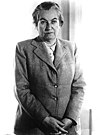 Pablo Neruda and Gabriela Mistral, Nobel Prize recipients in literature (1971 and 1945)
Pablo Neruda and Gabriela Mistral, Nobel Prize recipients in literature (1971 and 1945)
From the period between early agricultural settlements and up to the late pre-Hispanic period, northern Chile was a region of Andean culture that was influenced by altiplano traditions spreading to the coastal valleys of the north, while southern regions were areas of Mapuche cultural activities. Throughout the colonial period following the conquest, and during the early Republican period, the country's culture was dominated by the Spanish. Other European influences, primarily English, French, and German began in the 19th century and have continued to this day. German migrants influenced the Bavarian style rural architecture and cuisine in the south of Chile in cities such as Valdivia, Frutillar, Puerto Varas, Osorno, Temuco, Puerto Octay, Llanquihue, Faja Maisan, Pitrufquén, Victoria, Pucón and Puerto Montt.
Music and dance

Music in Chile ranges from folkloric, popular and classical music. Its large geography generates different musical styles in the north, center and south of the country, including also Easter Island and Mapuche music. The national dance is the cueca. Another form of traditional Chilean song, though not a dance, is the tonada. Arising from music imported by the Spanish colonists, it is distinguished from the cueca by an intermediate melodic section and a more prominent melody.
Between 1950 and 1970 appears a rebirth in folk music leading by groups such as Los de Ramón, Los Cuatro Huasos and Los Huasos Quincheros, among others with composers such as Raúl de Ramón, Violeta Parra and others. In the mid-1960s native musical forms were revitalized by the Parra family with the Nueva canción Chilena, which was associated with political activists and reformers such as Víctor Jara, Inti-Illimani, and Quilapayún. Other important folk singer and researcher on folklore and Chilean ethnography, is Margot Loyola. Also many Chilean Rock bands like Los Jaivas, Los Prisioneros, La Ley, and Los Tres have reached international success. In February, annual music festivals are held in Viña del Mar.
Literature
Chileans call their country país de poetas-country of poets. Gabriela Mistral was the first Latin American to receive a Nobel Prize in Literature (1945). Chile's most famous poet, however, is Pablo Neruda, who also received the Nobel Prize for Literature (1971) and is world-renowned for his extensive library of works on romance, nature, and politics. His three highly personalized homes, located in Isla Negra, Santiago and Valparaíso are popular tourist destinations.
Among the list of other Chilean poets are Carlos Pezoa Véliz, Vicente Huidobro, Gonzalo Rojas, Pablo de Rokha, Nicanor Parra and Raúl Zurita. Isabel Allende is the best-selling Chilean novelist, with 51 millions of her novels sold worldwide. Novelist José Donoso's novel The Obscene Bird of Night is considered by critic Harold Bloom to be one of the canonical works of 20th century Western literature. Another internationally recognized Chilean novelist and poet is Roberto Bolaño whose translations into English have had an excellent reception from the critics.
Cuisine

Chilean cuisine is a reflection of the country's topographical variety, featuring an assortment of seafood, beef, fruits, and vegetables. Traditional recipes include asado, cazuela, empanadas, humitas, pastel de choclo, pastel de papas, curanto and sopaipillas. Crudos is an example of the mixture of culinary contributions from the various ethnic influences in Chile. The raw minced llama, heavy use of shellfish and rice bread were taken from native Quechua Andean cuisine, (although now beef brought to Chile by Europeans is also used in place of the llama meat), lemon and onions were brought by the Spanish colonists, and the use of mayonnaise and yogurt was introduced by German immigrants, as was beer.
Folklore
The folklore of Chile, cultural and demographic characteristics of the country, is the result of mixture of Spanish and Amerindian elements that occurred during the colonial period.. Due to cultural and historical reasons, they are classified and distinguished four major areas in the country: Northern Areas, central, southern and south. Most of the traditions of the culture of Chile have a festive purpose, but some, such as dances and ceremonies have religious components.
Mythology
Main article: Chilean mythologyChilean mythology, is the mythology and beliefs of the Folklore of Chile.
This includes Chilote mythology, Rapa Nui mythology and Mapuche mythology.
Cinema
Main article: Cinema of ChileThe film originated in Valparaíso on May 26, 1902 with the premiere of the documentary Exercise General Fire Brigade, the first film completely filmed and processed in the country. In the following decades, marked milestones The deck of Death (or The Enigma of Lord Street) (1916), considered the first film Chilean story, 300 The transmission of presidential (1920), the first animated film in the country, and North and South (1934), the first sound film of Chile.
Sports
Main article: Sport in Chile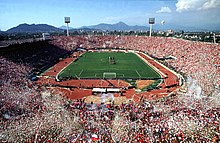
Chile's most popular sport is association football. Chile has appeared in eight FIFA World Cups which includes hosting the 1962 FIFA World Cup where the national football team finished third. Other results achieved by the national football team include four finals at the Copa América, one silver and two bronze medals at the Pan American Games, a bronze medal at the 2000 Summer Olympics and two third places finishes in the FIFA under-17 and under-20 youth tournaments. The top league in the Chilean football league system is the Chilean Primera División, which is named by the IFFHS as the ninth strongest national football league in the world.
The main football clubs are Colo-Colo, Universidad de Chile and Universidad Católica. Colo-Colo is the country's most successful football club, having both the most national and international championships, including the coveted Copa Libertadores South American club tournament. Universidad de Chile was the last international champion (Copa Sudamericana 2011).

Tennis is Chile's most successful sport. Its national team won the World Team Cup clay tournament twice (2003 & 2004), and played the Davis Cup final against Italy in 1976. At the 2004 Summer Olympics the country captured gold and bronze in men's singles and gold in men's doubles. Marcelo Ríos became the first Latin American man to reach the number one spot in the ATP singles rankings in 1998. Anita Lizana won the US Open in 1937, becoming the first woman from Latin America to win a Grand Slam tournament. Luis Ayala was twice a runner-up at the French Open and both Ríos and Fernando González reached the Australian Open men's singles finals. González also won a silver medal in singles at the 2008 Summer Olympics in Beijing.
At the Summer Olympic Games Chile boasts a total of two gold medals (tennis), seven silver medals (athletics, equestrian, boxing, shooting and tennis) and four bronze medals (tennis, boxing and football). In 2012, Chile won its first Paralympic Games medal (gold in Athletics).
Rodeo is the country's national sport and is practiced in the more rural areas of the nation. A sport similar to hockey called chueca was played by the Mapuche people during the Spanish conquest. Skiing and snowboarding are practiced at ski centers located in the Central Andes, and in southern ski centers near to cities as Osorno, Puerto Varas, Temuco and Punta Arenas. surfing is popular at some coastal towns. Polo is professionally practiced within Chile and in 2008 Chile achieved top prize in the World Polo Championship a tournament where the country has earned both second and third places medals in previous editions.
Basketball is a popular sport in which Chile has earned a bronze medal in the first men's FIBA World Championship held in 1950 and winning a second bronze medal when Chile hosted the 1959 FIBA World Championship. Chile hosted the first FIBA World Championship for Women in 1953 finishing the tournament with the silver medal. San Pedro de Atacama is host to the annual "Atacama Crossing", a six-stage, 250-kilometre (160 mi) footrace which annually attracts about 150 competitors from 35 countries. The Dakar Rally off-road automobilie race has been held in both Chile and Argentina since 2009.
Cultural heritage

The cultural heritage of Chile consists, first, of their intangible heritage, composed of various cultural events, such as visual arts, crafts, dances, holidays, cuisine, games, music and traditions, and, secondly, by its tangible, consists of those buildings, objects and sites of archaeological, architectural, traditional, artistic, ethnographic, folkloric, historical, religious or technological scattered through Chilean territory, among them, those goods are declared World Heritage site by Unesco, in accordance with the provisions of the Convention concerning the Protection of World Cultural and Natural Heritage of 1972, ratified by Chile in 1980. These cultural sites are the Rapa Nui National Park (1995), the churches of Chiloé (2000), the historical district of the port city of Valparaíso (2003), the nitrate of Humberstone and Santa Laura (2005) and the city Sewell Mining (2006).
In 1999, he established the Heritage Day as a way to recognize the architectural heritage, cultural and historical Chile.
See also
References
- "100 peso Coin". Central Bank of Chile. Retrieved 16 September 2012.
- "CIFRAS DE ENVEJECIMIENTO Y MIGRACIÓN MUESTRAN UN CHILE DISTINTO AL DE HACE UN DECENIO". POBLACIÓN PAÍS Y REGIONES – ACTUALIZACIÓN 2002–2012. National Statistics Institute. 4 September 2014. Retrieved 4 September 2014.
- "Revisión del cuestionado Censo 2012 reduce población chilena a 16.341.929" (in Spanish). Emol. Retrieved 26 February 2014.
- ^ "Legacies, Clouds, Uncertainties". International Monetary Fund web site. October 2014. Retrieved 24 October 2014.
- "Society at a Glance : Social Indicators OECD" (PDF). OECD. October 2012. Retrieved 28 October 2013.
- "2014 Human Development Report Summary" (PDF). United Nations Development Programme. 2014. pp. 21–25. Retrieved 27 July 2014.
- "Chile". Dictionary.reference.com. Retrieved 14 November 2010.
- "Bureau of Western Hemisphere Affairs, Background Note: Chile". United States Department of State. 16 December 2011.
- ^ "Chile". The World Factbook. Central Intelligence Agency. Retrieved 17 February 2014.
- ^ "Country profile: Chile". BBC News. 16 December 2009. Retrieved 31 December 2009.
- ^ "Human and income poverty: developing countries". UNDP.
- "World Development Indicators". World Bank. 17 April 2012. Retrieved 12 May 2012.
- "Chile.com.La Incógnita Sobre el Origen de la Palabra Chile". Chile.com. 15 June 2000. Retrieved 17 December 2009.
- Encyclopædia Britannica. "Picunche (people) – Britannica Online Encyclopedia". Britannica.com. Retrieved 17 December 2009.
- ^ Encina, Francisco A., and Leopoldo Castedo (1961). Resumen de la Historia de Chile. 4th ed. Santiago. Vol. I. Zig-Zag. p. 44.
{{cite book}}: CS1 maint: multiple names: authors list (link) - "Chile". Encyclopedia Americana. Grolier Online. 2005. Retrieved 2 March 2005.
The name Chile is of Native American origin, meaning possibly "ends of the earth" or simply "sea gulls."
- ^ Hudson, Rex A., ed. (1995). "Chile: A Country Study". GPO for the Library of Congress. Retrieved 27 February 2005.
{{cite web}}:|author=has generic name (help)CS1 maint: multiple names: authors list (link) - ^ "CHILE". Encyclopædia Britannica. 11th ed. 1911. ("derived, it is said, from the Quichua chiri, cold, or tchili, snow")
- "Chile (república)". Enciclopedia Microsoft Encarta Online. 2005. Retrieved 26 February 2005.
The region was then known to its native population as Tchili, a Native American word meaning "snow".
Archived 31 October 2009. - Pearson, Neale J. (2004). "Chile". Grolier Multimedia Encyclopedia. Scholastic Library Publishing. Retrieved 2 March 2005.
Chile's name comes from an Indian word, Tchili, meaning "the deepest point of the Earth."
- de Olivares y González SJ, Miguel (1864) . Imprenta del Ferrocarril (ed.). Historia de la Compañía de Jesús en Chile. Vol. 4. Santiago.
{{cite book}}: CS1 maint: location missing publisher (link) - Appletons' annual cyclopaedia and register of important events of the year: 1900. New York: Appletons. p. 87.
- Insight Guides: Chile. Langenscheidt Publishing Group. 2002. p. 27. ISBN 978-981-234-890-6. Retrieved 14 July 2013.
- ^ "Development and Breakdown of Democracy, 1830–1973". Country Studies. Library of Congress. 31 March 1994.
- "Bárbaros, page 66. David J. Weber". Archive.org.
- "INE – Censo de 1813. Introducción" (PDF).
- Fowler, Will (1996). Authoritarianism in Latin America since independence. University of Virginia: Geenwood Press. pp. 30–96. ISBN 0-313-29843-2.
- Frazier, Lessie Jo (17 July 2007). Salt in the Sand: Memory, Violence, and the Nation-State in Chile, 1890 to the Present. Duke University Press. pp. 163–184. ISBN 978-0-8223-4003-4. Retrieved 14 July 2013.
- Mares, David; Francisco Rojas Aravena (2001). The United States and Chile: Coming in from the Cold. Routledge. p. 145. ISBN 978-0-415-93125-0. Retrieved 14 July 2013.
- Trento, Joseph J. (2005). The Secret History Of The CIA. Carroll & Graf Publishers. p. 560. ISBN 978-0-7867-1500-8. Retrieved 14 July 2013.
- Lois Hecht Oppenheim (2007). Politics in Chile: Socialism, Authoritarianism, and Market Democracy. Westview Press. p. 52. ISBN 978-0-7867-3426-9. Retrieved 14 July 2013.
- ^ De Vylder, Stefan (5 March 2009). Allende's Chile: The Political Economy of the Rise and Fall of the Unidad Popular. Cambridge University Press. ISBN 978-0-521-10757-0.
- "Allende wins the elections: first coup attempt". Grace.evergreen.edu. Archived from the original on 7 January 2008. Retrieved 17 December 2009.
- ^ Friedman, Norman (1 March 2007). The Fifty-Year War: Conflict and Strategy in the Cold War. Naval Institute Press. pp. 367–368. ISBN 978-1-59114-287-4. Retrieved 14 July 2013.
- Qureshi, Lubna Z. (2009). Nixon, Kissinger, and Allende: U.S. Involvement in the 1973 Coup in Chile. Lexington Books. pp. 86–97. ISBN 978-0-7391-2655-4. Retrieved 14 July 2013.
- "Report on CIA Chilean Task Force activities". Chile and the United States: Declassified Documents relating to the Military Coup, 1970–1976. The National Security Archive: Electronic Briefing Books (George Washington University). Retrieved 11 March 2010.
- ^ "Covert Action In Chile 1963–1973, Staff Report Of The Select Committee To Study Governmental Operations With Respect To Intelligence Activities". Federation of American Scientists. Retrieved 17 December 2009.
- "Tightening the Belt". Time Magazine. 7 August 1972.
- "Equipo Nizkor – CIA Activities in Chile – September 18, 2000". Derechos.org. Retrieved 17 December 2009.
- "Transition to Democracy in Latin America: The Role of the judiciary" (PDF). Yale University.
- Soto, Óscar (1999). El último día de Salvador Allende. Aguilar. ISBN 978-956-239-084-2.
- Ahumada, Eugeno. Chile: La memoria prohibida.
- "KISSINGER AND CHILE: THE DECLASSIFIED RECORD". The national security archive. 16 September 2013. Retrieved 16 September 2013.
- "Flashback: Caravan of Death". BBC. 25 July 2000.
- Ministerio del Interior (3 August 1999). "Ministerio del Interior, Programa de Derechos Humanos – ddhh_rettig". Ddhh.gov.cl. Retrieved 17 December 2009.
- ^ "Sintesis Ok" (PDF). Retrieved 17 December 2009.
- Pamela Constable; Arturo Valenzuela (1993). A Nation of Enemies: Chile Under Pinochet. W W Norton & Company Incorporated. p. 150. ISBN 978-0-393-30985-0.
- Naomi Klein (1 April 2010). The Shock Doctrine: The Rise of Disaster Capitalism. Henry Holt and Company (2007). p. 85. ISBN 978-1-4299-1948-7. Retrieved 14 July 2013.
- Huneeus, Carlos (3 September 2009). "Political Mass Mobilization against Authoritarian Rule: Pinochet's Chile, 1983–88". In Adam Roberts; Timothy Garton Ash (ed.). Civil Resistance and Power Politics:The Experience of Non-violent Action from Gandhi to the Present. Oxford University Press. pp. 197–212. ISBN 978-0-19-161917-5. Retrieved 14 July 2013.
{{cite book}}: CS1 maint: multiple names: editors list (link) - Christian, Shirley (16 December 1989). "Man in the News: Patricio Aylwin; A Moderate Leads Chile". The New York Times.
- "Chile elects new leader Late president's son wins big". Encyclopedia.com. 12 December 1993. Archived from the original on 26 May 2008. Retrieved 14 July 2013.
- "Moderate socialist Lagos wins Chilean presidential election". CNN. 16 January 2000. Archived from the original on 6 May 2008.
- "Chile elects first woman president". MSNBC.
- Reel, Monte (12 March 2006). "Bachelet Sworn In As Chile's President". The Washington Post.
- "US ready to help Chile: Obama". The Australia Times. Retrieved 3 March 2010.
- More Quakes Shake Chile’s Infrastructure, Adam Figman, Contract Magazine, 1 March 2010
- "Background Note: Chile". Bureau of Western Hemisphere Affairs, United States Department of State. 16 December 2011. Retrieved 19 March 2012.
- "Chile". Encyclopædia Britannica. Retrieved 7 May 2013.
- "Antarctic Treaty: Information about the Antarctic Treaty and how Antarctica is governed". Polar Conservation Organisation. Polar Conservation Organisation. 1 February 2008. Retrieved 11 March 2010.
- Blanco, Alejandro Vergara (1998). Derecho de aguas. Editorial Jurídica de Chile. ISBN 978-956-10-1241-7. Retrieved 14 July 2013.
- Chile: Ciudades, Pueblos, Aldeas y Caseríos 2005, Instituto Nacional de Estadísticas – June 2005.
- ^ "Icarito: Enciclopedia de la flora y fauna de Chile". Icarito.
- Oehrens, E.B. "Flora Fungosa Chilena". Universidad de Chile, Santiago de Chile, 1980
- "Cybertruffle's Robigalia – Observations of fungi and their associated organisms". cybertruffle.org.uk. Retrieved 9 July 2011.
- Kirk, P.M., Cannon, P.F., Minter, D.W. and Stalpers, J. "Dictionary of the Fungi". Edn 10. CABI, 2008
- "Fungi of Chile – potential endemics". cybertruffle.org.uk. Retrieved 9 July 2011.
- ^ Smith-Ramírez, Cecilia (27 October 2006). "Distribution patterns of flora and fauna in southern Chilean Coastal rain forests: Integrating Natural History and GIS". Biodiversity and Conservation (Volume 16, Number 9 / August 2007). Springer Netherlands. doi:10.1007/s10531-006-9073-2.
{{cite journal}}:|issue=has extra text (help) - ^ Niemeyer, Hans, y Pilar Cereceda (1983). "Hydrography". Geography of Chile. 8 (1st ed.). Santiago: Military Geographic Institute.
{{cite journal}}:|access-date=requires|url=(help)CS1 maint: multiple names: authors list (link) - "Anuario Estadísticas Vitales 2003". Instituto National de Estadísticas.
- "Chile: Proyecciones y Estimaciones de Población. Total País 1950–2050" (PDF). Instituto National de Estadísticas.
- "List of Chilean cities". Observatorio Urbano, Ministerio de Vivienda y Urbanismo de Chile.
- "La riqueza de los chilenos está en su gran diversidad genética". El Mercurio. 12 September 2010. Retrieved 22 September 2011.
- Lizcano Fernández (2005). "Composición étnica de las tres áreas culturales del continente americano al comienzo del siglo XXI" (PDF). UAEM. ISSN 1405-1435.
- "Estudio genético en chilenos muestra desconocida herencia africana | El Dínamo". Eldinamo.cl. 19 August 2013. Retrieved 22 December 2013.
- Godinho, Neide Maria de Oliveira (2008). "O impacto das migrações na constituição genética de populações latino-americanas". Universidade de Brasília. Retrieved 29 March 2013.
- "5.2.6. Estructura racial". La Universidad de Chile. Retrieved 26 August 2007. (Main page)
- "Informe Latinobarómetro 2011". Latinobarometro.org. Retrieved 13 July 2013.
- "Encuesta CEP, Julio 2002" (in Spanish). July 2002. Retrieved 18 May 2012.
- "1907 census". Memoriachilena.cl.
- "Censo 2002 – Síntesis de Resultados" (PDF). Instituto Nacional de Estadísticas.
- "El gradiente sociogenético chileno y sus implicaciones ético-sociales". Medwave.cl. 15 June 2000.
- "ILOLEX: submits English query". Ilo.org. 9 January 2004.
- "Chile's Supreme Court Upholds Indigenous Water Use Rights". The Santiago Times. 30 November 2009. Retrieved 2 March 2010.
- ^ Waldo Ayarza Elorza. "De los Vascos, Oñati y los Elorza" (PDF). pp. 59, 65, 66. Retrieved 13 July 2013.
- ^ Salazar Vergara, Gabriel; Pinto, Julio (1999). "La Presencia Inmigrante". Historia contemporánea de Chile: Actores, identidad y movimiento. II. Lom Ediciones. pp. 76–81. ISBN 978-956-282-174-2. Retrieved 14 July 2013.
- Censo de población de 1907, page-PDF 55/1277 and page-PDF 1249/1277 Instituto Nacional de Estadísticas de Chile
- Hoofdstuk XVI Historisch tussenspel Template:Nl icon
- "Dutch immigration". Cstandt.com.
- Durán, Hipólito (1997). "El crecimiento de la población latinoamericana y en especial de Chile • Academia Chilena de Medicina". Superpoblación. Madrid: Real Academia Nacional de Medicina. p. 217. ISBN 84-923901-0-7. Retrieved 16 September 2012.
{{cite book}}: Cite has empty unknown parameters:|chapterurl=and|trans_chapter=(help) - Pérez Rosales, Vicente (1860/1975). Recuerdos del Pasado. Santiago de Chile: Editorial Andrés Bello. Retrieved 16 September 2012.
{{cite book}}: Check date values in:|year=(help); Cite has empty unknown parameters:|chapterurl=and|trans_chapter=(help)CS1 maint: year (link) - "entrevista al Presidente de la Cámara vasca". Deia.com. 22 May 2008.
- "Chile: Moving Towards a Migration Policy". Migrationinformation.org. Retrieved 1 August 2011.
- Landaburu, Juan (24 June 2007). "El debate sobre la inmigración ilegal se extiende a la región". La Nación. Retrieved 31 December 2008.
- "Estimación de Población de Extranjeros en Chile a Diciembre de 2008" (PDF). Departamento de Extranjería y Migración. Retrieved 13 July 2013.
- "Chile: Palestinian refugees arrive to warm welcome". Adnkronos.com. 7 April 2003.
- "500,000 descendientes de primera y segunda generación de palestinos en Chile". Laventana.casa.cult.cu. Retrieved 13 July 2013.
- ^ 8 236 900 out of 12 366 108 people over 15 years of age. "Population 15 years of age or older, by religion, region, sex and age groups. (censused population)" (.xls). Censo 2012 (in Spanish). Retrieved 1 March 2014.
- 7 853 428 out of 11 226 309 people over 15 years of age. "Population 15 years of age or older, by religion, administrative division, sex and age groups" (PDF). Censo 2002 (in Spanish). Retrieved 1 March 2014.
- ^ "Chile". International Religious Freedom Report. United States Department of State. 19 September 2008.
- "Hola, Luther". The Economist. 6 November 2008. (Archived: 10 December 2008)
- Andrea Henríquez (31 October 2008). "Los evangélicos tienen su feriado". BBC Mundo. Retrieved 17 December 2009.
- "Patron Saints: 'C'". Catholic Online. Retrieved 28 June 2012.
- "Las fechas del proceso de Canonización del Padre Hurtado" (in Spanish). Archived from the original on 22 January 2008. Retrieved 9 January 2008.
{{cite web}}: Unknown parameter|deadurl=ignored (|url-status=suggested) (help) - "Ethnologue report for Chile". Ethnologue.com. Retrieved 1 August 2011.
- Oliver Zoellner. "Oliver Zoellner | Generating Samples of Ethnic Minorities in Chile". Research-worldwide.de. Retrieved 17 December 2009.
- "Repeat after me: Hello, my name is". Globalpost.com.
- "Anglicism in Chilean Spanish". Scielo.cl. 4 May 2004.
- "A Country Study: Chile". United States Library of Congress.
- "Chile scraps Pinochet-era system". BBC. 16 August 2005. Retrieved 31 December 2009.
- "President Lagos: We can make a greater effort to make yesterday's and today's trials equally just". Chilean Government.
- "United Nations Member States". United Nations. Retrieved 1 August 2011.
- "United Nations Member States". United Nations. Retrieved 1 August 2011.
- "The San Francisco Conference: Chile Signs United Nations Charter".
- "Election (13 May 2010) Human Rights Council". 64th Session. United Nations General Assembly.
- "Chad, Chile, Lithuania, Nigeria and Saudi Arabia were elected to serve on the UN Security Council". United Nations. 17 October 2013. Retrieved 17 October 2013.
- "Organigrama". Gobierno de Chile.
- "Chile flag and description". Worldatlas.com. Retrieved 1 August 2011.
- "Chilean Army Commander-in-Chief Visits WJPC".
- "Army War College Community Banner".
- "The Navy's most valuable asset: its people". Wayback.archive.org. Retrieved 13 July 2013.
- "The National Fleet". Chilean Navy. Archived from the original on 10 June 2007. Retrieved 30 May 2014.
- "Submarine Force". Wayback.archive.org. Retrieved 14 July 2013.
- "Carabineros de Chile". Wayback.archive.org. 24 October 2007. Retrieved 13 July 2013.
- "How We Classify Countries". World Bank. Retrieved 1 July 2013.
- "Country and Lending Groups". High-income economies ($12,616 or more): The World Bank. 1 July 2013. Retrieved 14 September 2013.
{{cite web}}: CS1 maint: location (link) - "GNI per capita, Atlas method (current US$)" (xls). Washington, D.C.: The World Bank. 1 August 2013. Retrieved 14 September 2013.
GNI-WB
- "Chile". Index of Economic Freedom. Heritage Foundation. Retrieved 13 July 2013.
- "Chile's accession to the OECD". OECD.org. 7 May 2010.
- http://www.weforum.org/pdf/GCR09/GCR20092010fullrankings.pdf
- ^ "Mining in Chile: Copper solution". The Economist. 27 April 2013. Retrieved 13 July 2013.
- "Chile GDP – real growth rate". Indexmundi.com. 21 February 2013. Retrieved 13 July 2013.
- "Chile finmin says no recession seen in 2009-report". Reuters. 10 January 2009. Retrieved 17 December 2009.
- ^ "Chile: 2013 Article IV Consultation; IMF Country Report 13/198" (PDF). IMF. 14 June 2013. Retrieved 13 July 2013.
- "Chile February–April Unemployment Rises to 6.4% From 6.2% in January–March". WSJ.com. Retrieved 13 July 2013.
- "Casen 2006 en profundidad" (PDF). Libertad y Desarrollo. 22 June 2007. Archived from the original (PDF) on 25 October 2007. Retrieved 22 October 2007.
- "Panorama social de América Latina" (PDF). ECLAC. 2010. Retrieved 13 July 2013.
- "Una muy necesaria corrección: Hay cuatro millones de pobres en Chile". El Mercurio. 14 October 2007. Retrieved 22 October 2007.
- "Destitute no more". The Economist. 16 August 2007. Retrieved 22 October 2007. (subscription required)
- "Ficha de Protección Social – Ministerio de Desarrollo Social". Fichaproteccionsocial.gob.cl. 20 November 2012. Retrieved 12 March 2013.
- "Ficha de Protección Social – Ministerio de Desarrollo Social". Fichaproteccionsocial.gob.cl. Retrieved 9 November 2012.
- "The Chilean pension system" (PDF). Retrieved 13 July 2013.
- "An uncertain future". GlobalPost. Retrieved 17 December 2009.
- "USA-Chile FTA Final Text". Ustr.gov. Retrieved 13 July 2013.
- "UPDATE 2-S&P raises Chile's credit rating to AA-minus". Reuters. 26 December 2012. Retrieved 13 July 2013.
- "Guía del Viajero" (in Spanish). Metro de Santiago. Retrieved 18 September 2013.
{{cite web}}: Unknown parameter|trans_title=ignored (|trans-title=suggested) (help) - Omnilineas. "Omnilineas website".
- "Percentage of Individuals using the Internet 2000–2012", International Telecommunications Union (Geneva), June 2013, retrieved 22 June 2013
- http://wayback.archive.org/web/20080408235147/http://www.rides.cl/pdf/trade_tourism_chile.pdf
- "Pro|Chile – Importadores | Selección idiomas". Prochile.us. Retrieved 22 December 2013.
- "Chile Country Profile, UNESCO-UNEVOC".
- "Mensualidad de los colegios con los mejores puntajes en la PSU supera los $250 mil". Emol.com. 30 December 2013. Retrieved 18 July 2014.
- "Program in Chile | Yale Law School". Law.yale.edu. Retrieved 22 December 2013.
- "Valdivia Chile". Allsouthernchile.com. Retrieved 1 August 2011.
- International Web Solutions, Inc. <http://www.iwsinc.net>. "Latin America :: Chile". Global Adrenaline. Retrieved 1 August 2011.
{{cite web}}: External link in|author= - "Learning About Each Other". Learnapec.org. Retrieved 1 August 2011.
- "Chile Foreign Relations". Country-studies.com. Retrieved 1 August 2011.
- "Food in Chile – Chilean Food, Chilean Cuisine – traditional, popular, dishes, recipe, diet, history, common, meals, rice, main, people, favorite, customs, fruits, country, bread, vegetables, bread, drink, typical". Foodbycountry.com. Retrieved 1 August 2011.
- "Memoria Chilena". Memoriachilena.cl.
- "Conjuntos Folkloricos de Chile". Musicapopular.cl.
- Martinez, Jessica. "Top Cultural Celebrations and Festivals in Chile". USA Today.
- "Un mapa por completar: la joven poesia chilena – ¿Por qué tanta y tan variada poesía?". Uchile.cl. Retrieved 17 December 2009.
- "Latin American Herald Tribune – Isabel Allende Named to Council of Cervantes Institute". Laht.com. Retrieved 14 November 2010.
- Grossman, Lev (10 November 2008). "Bolaño's 2666: The Best Book of 2008". Time. Retrieved 28 April 2010.
- Sarah Kerr (18 December 2008). "The Triumph of Roberto Bolaño". The New York Review of Books.
- Wood, James (15 April 2007). "The Visceral Realist". The New York Times. Retrieved 1 April 2010.
- Maria Baez Kijac (2003). The South American Table: The Flavor and Soul of Authentic... Harvard Common Press. ISBN 978-1-55832-249-3. Retrieved 14 July 2013.
- "The strongest National League in the World 2011". IFFHS. Retrieved 18 April 2012.
Further reading
- Simon Collier and William F. Sater, A History of Chile, 1808–1894, Cambridge University Press, 1996
- Paul W. Drake, and others., Chile: A Country Study, Library of Congress, 1994
- Luis Galdames, A History of Chile, University of North Carolina Press, 1941
- Brian Lovemen, Chile: The Legacy of Hispanic Capitalism, 3rd ed., Oxford University Press, 2001
- John L. Rector, The History of Chile, Greenwood Press, 2003
External links
- Official Chile website
- Government of Chile
- "Chile". The World Factbook (2025 ed.). Central Intelligence Agency.
- Chile from UCB Libraries GovPubs
- Template:Dmoz
- Chile profile from the BBC News
- Road maps of Chile, interactive
- World Bank Summary Trade Statistics Chile
 Wikimedia Atlas of Chile
Wikimedia Atlas of Chile Geographic data related to Chile at OpenStreetMap
Geographic data related to Chile at OpenStreetMap- Key Development Forecasts for Chile from International Futures
- Chile Cultural Society
| Chile articles | |||||||||||
|---|---|---|---|---|---|---|---|---|---|---|---|
| History |
|  | |||||||||
| Geography | |||||||||||
| Politics |
| ||||||||||
| Economy | |||||||||||
| Society |
| ||||||||||